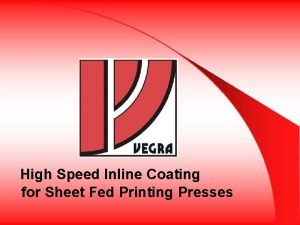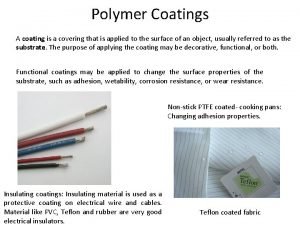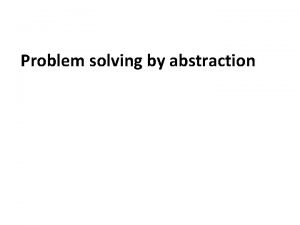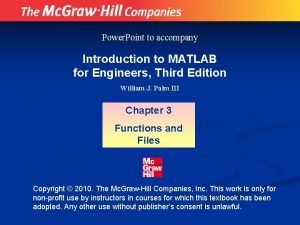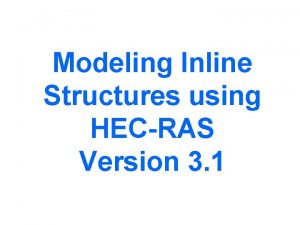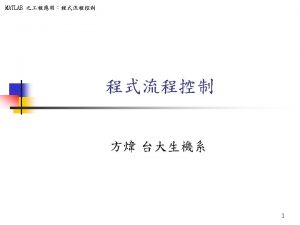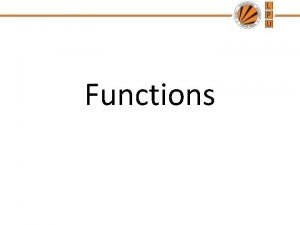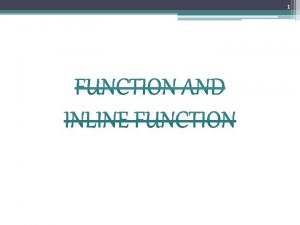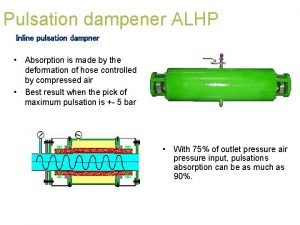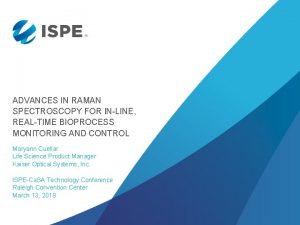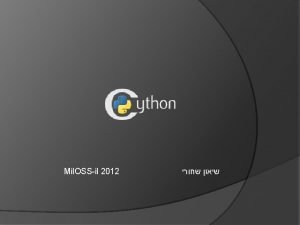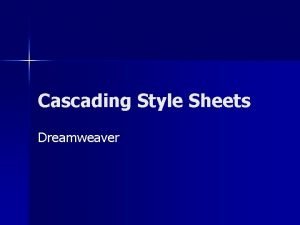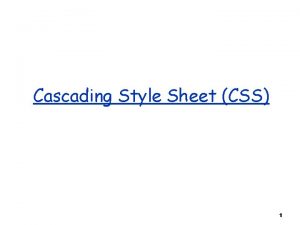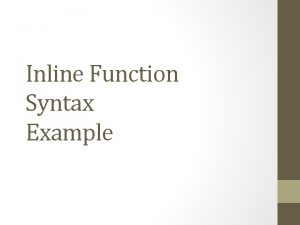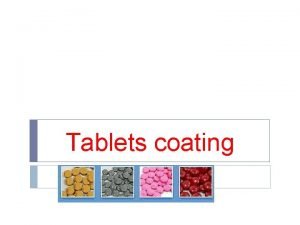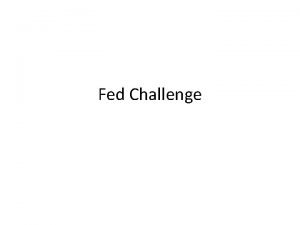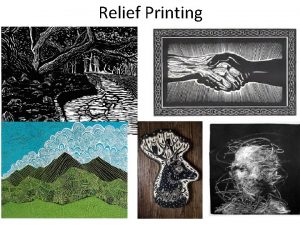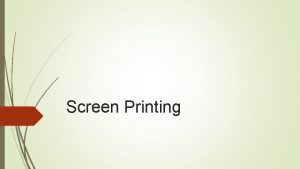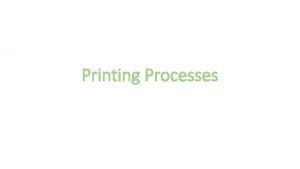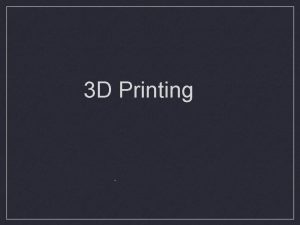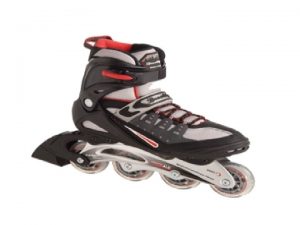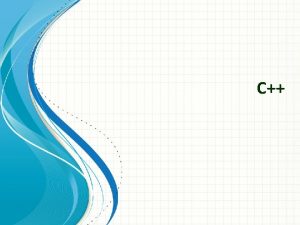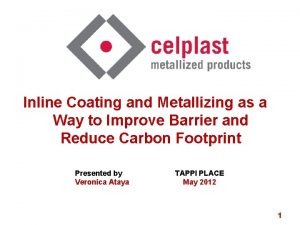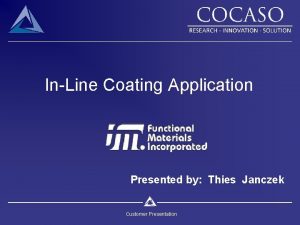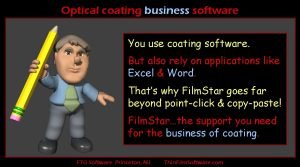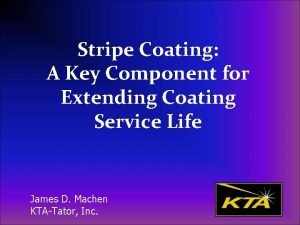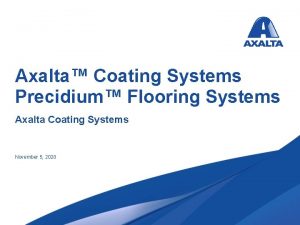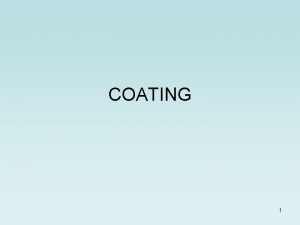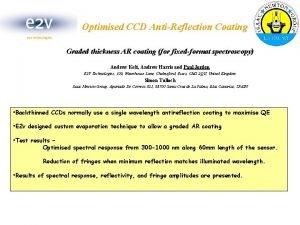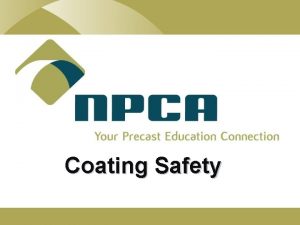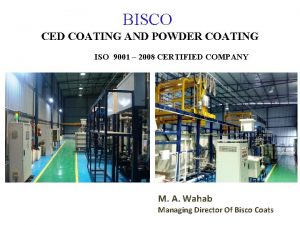High Speed Inline Coating for Sheet Fed Printing
























- Slides: 24

High Speed Inline Coating for Sheet Fed Printing Presses

High Speed Inline Coating for Sheet Fed Printing Presses Ø Preconditions - up to 12, 000 prints/h the usual processing instructions are to be observed - for High Speed Inline Coating with a printing speed of up to 18, 000 sheets/h the processing range must be adapted regarding - substrate - ink layer thickness - coating viscosity - coating selection - performance of the dryer - distance under the dryer

High Speed Inline Coating for Sheet Fed Printing Presses Ø Substrate - Ink - the combination of substrate and ink should be selected in a way to assure a good bond between ink and substrate - poor ink drying cannot be improved by coating - the result is bad rub resistance and insufficient scotch tape resistance

High Speed Inline Coating for Sheet Fed Printing Presses Ø Adhesion Substrate - Ink

High Speed Inline Coating for Sheet Fed Printing Presses Ø Ink Layer Thickness - Overinking of the ink layer thickness with parallel inline coating will reduce the performance of the printing press - as by reducing the printing speed the drying time is adjusted

High Speed Inline Coating for Sheet Fed Printing Presses Ø Ink Layer Thickness

High Speed Inline Coating for Sheet Fed Printing Presses Ø Cell Volume of the Screen Rollers - the cell volume of a screen roller is indicated with the scoop amount of water in ml/m² - the coating application amount corresponds to about 1/3 of the indicated cell volume of the screen roller Example: A cell volume of the screen roller of 15 g/m² corresponds to approx 5 g/m² coating application

High Speed Inline Coating for Sheet Fed Printing Presses Ø Gloss Diagram after 24 h Drying Gloss in % Wet-on. Wet Printing 3 g/m² 2 g/m² 1 g/m² Drying Time in h

High Speed Inline Coating for Sheet Fed Printing Presses Ø Coating Viscosity - the coating viscosity depends on the temperature and is determined with a 4 mm DIN cup at 20°C - when the temperature in the coating rises the viscosity will decrease - in case of a viscosity decrease, e. g. below 25 sec. , an even coating application cannot be assured any more

High Speed Inline Coating for Sheet Fed Printing Presses Viscosity in s Ø Viscosity depending on the Temperature in °C

High Speed Inline Coating for Sheet Fed Printing Presses ØVariable Coating Viscosities Cooling Units for Coatings by EASYLAC keep the coating stable in viscosity

High Speed Inline Coating for Sheet Fed Printing Presses Ø Too high Coating Viscosity - a too high coating viscosity, e. g. above 65 sec. can be adjusted by dilution with water to the required viscosity -a too high coating viscosity in connection with High Speed Inline Coating will lead to splashing

High Speed Inline Coating for Sheet Fed Printing Presses Viscosity in sec. DIN 4 mm Cup at 20 °C Ø Dilution of the Coatings with Water approximate Water Amount in %

High Speed Inline Coating for Sheet Fed Printing Presses ØCoating Selection - the drying behaviour of coatings depend on the coating type - if for example the following coating types are used: - matt - semi matt - protection - gloss - high gloss - UV coatings their drying behaviour will be considerably different

High Speed Inline Coating for Sheet Fed Printing Presses ØCoating Selection Rule of thumb: For dispersion coatings: The higher the gloss, the slower the thorough drying

High Speed Inline Coating for Sheet Fed Printing Presses ØGloss Diagram: different coatings on the same substrate

High Speed Inline Coating for Sheet Fed Printing Presses Ø Influence of the Surface Structure of the Substrate Gloss in % Carton 1 Carton 2 Application Amount g/m² wet

High Speed Inline Coating for Sheet Fed Printing Presses ØUV Coatings - UV coatings dry immediately by photo -polymerisation using short wave light - the acetone test shows whether the coatings have dried thoroughly

High Speed Inline Coating for Sheet Fed Printing Presses ØPerformance of the Dryers - the drying behaviour of the coatings is determined by the performance of the dryer - the thorough drying of dispersion coatings is primarily determined by the available amount of air The more air, the better for the thorough drying - beginning at a pile temperature of approx. 35 °C problems may occur in the pile

High Speed Inline Coating for Sheet Fed Printing Presses ØDrying of UV Coatings - for UV coating processes the condition of the UV lamps and a sufficient performance are responsible for a good coating result - the temperature in the pile is also decisive for UV coatings and may be responsible for subsequent problems in print finishing - too high temperatures may result in breaking of the printed matter during the grooving and folding process

High Speed Inline Coating for Sheet Fed Printing Presses ØDrying Distance An extended delivery between coating tower and delivery is advantageous for the printing speed. A short delivery is a disadvantage for High Speed Inline Coating.

High Speed Inline Coating for Sheet Fed Printing Presses ØPrinting Press with Double Extended Delivery

High Speed Inline Coating for Sheet Fed Printing Presses ØSpecial Coating Applications - for special coating applications, as e. g. application of blister coating, a coating amount of 6 – 8 g/m² has to be applied in order to assure good bonding with the plastic foil

High Speed Inline Coating for Sheet Fed Printing Presses Ø Result High Speed Inline Coating with 18. 000 prints/h will not present any problems if the appropriate coatings are used and the printing press is well adjusted.
 Inline coating
Inline coating Passengers can help a driver manage emotions by
Passengers can help a driver manage emotions by Spin coating speed
Spin coating speed User response in computer
User response in computer Is scanner input or output
Is scanner input or output Speed time and distance formula
Speed time and distance formula Speed detection of moving vehicle using speed cameras
Speed detection of moving vehicle using speed cameras Abstraction problem solving
Abstraction problem solving Inline function matlab
Inline function matlab Inline structure hec ras
Inline structure hec ras Inline function matlab
Inline function matlab What is inline function
What is inline function Inline internal and external javascript
Inline internal and external javascript Inline functions
Inline functions Inline hockey vs ice hockey
Inline hockey vs ice hockey Inline pulsation dampener
Inline pulsation dampener Double bastion inline
Double bastion inline Double bastion inline
Double bastion inline Single bastion inline
Single bastion inline Kaiser raman probe
Kaiser raman probe Matplotlib inline
Matplotlib inline Cython inline
Cython inline Dreamweaver inline css
Dreamweaver inline css Cascade inline unit
Cascade inline unit What is inline function
What is inline function
